The main objective is to achieve the consistency in recommended configuration, use and placement of wellbore cleanup tools in the well to optimize the procedure of clean-up and displacement.
Because of the nature of wellbore cleanup operations is such that both the configuration and positioning of individual tools and the procedures can vary depending on customer objectives and preferences, local practices and also compatibility of different tools. These guidelines have been designed to provide general guidance on the selection of tools for different well types and to assist in the design or planning of wellbore cleanup operations and the preparation of procedures and equipment.
PUP Combination Tools
Pup casing cleanup tools can be configured as multi-function combination tools with up to 4 different, short, non-rotating, cleaning elements which are Scraper, Brush, Junk Basket and Magnet. Below is the guideline for optimum performance:
- If the tools is configured with one of more scrapers, it or they should always be run at the bottom of the tool, ahead of any other cleaning elements. This is on the basis that the most aggressive cleaning element should always be run first in the well.
- Brushes should always be run below Magnets and Junk Baskets. This is on the basis that if Magnets or Junk Baskets are run ahead of Brushes they are likely to become overloaded with debris as the tool is RIH. This could then cause circulation problems and the potential to leave debris in the well.
- Junk Baskets should always be run below Magnets. This is on the basis that if a Magnet becomes overloaded with ferrous debris the Junk Basket will catch at least some of the debris as the tool is pulled out of the hole.
If a tool without Magnets is configured with one or more Junk Baskets, it or they should always be run above the other elements at the top of the tool. This is to ensure that the required drop in annular velocity above the Junk Basket, for it to work effectively, is achieved.
To be noted that the Junk Basket explained here is for wellbore clean-up operations, not for fishing operations.
General Scraper, Brush, and Magnet Tool Selection Guidelines
There are different types of Scrapers, Brushes and Magnets tools.
- PUPs can be run fully loaded with up to 4 cleaning elements of the same type as a single function Scraper or Brush or Magnet tool.
- The normal Casing Scrapers and Casing Brushes tools (non-rotational) are single function tools with non-rotating cleaning elements that are longer and more aggressive than the single PUP elements.
- Casing Magnet tools (ferrous debris catcher tool) are also single function tools that have longer elements but have less magnetic surface area than a PUP that is fully loaded with 4 magnet elements.
- Convention Casing Scrapers and Brushes tools have rotating cleaning elements which does not fit with today’s customer requirement, unless specific order may requires. Using the non-rotating types of casing cleaning tools is mandatory by customers.
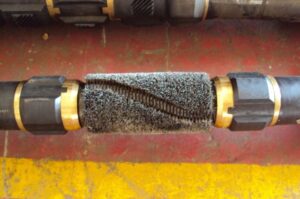
The table below lists recommendations on the types and combinations of these tools to be used in certain positions in different well types or conditions. The tools in bold are those recommended and considered “fit for purpose” for the given conditions. The alternative tools are also considered technically acceptable if the preferred tools are not available.
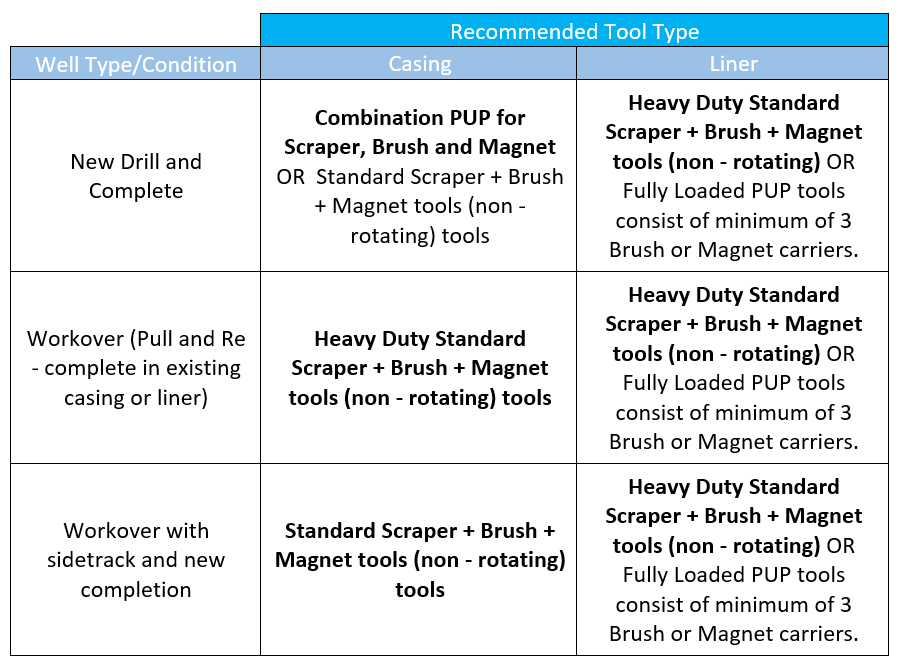
Specific Placement of Tools
Below is the guidelines on the placement of the different types of tools, on a tool by tool basis, together with any exceptions or other considerations when planning a Wellbore Clean-Up. Specific operating parameters for individual types of tools are available in the relevant tools technical data from the manufacturers.
Standard Casing Brush Tool (Non-Rotating Type)
Recommended position in the string will be:
- Above the casing scraper tool
- Above the well debris catcher tool (with integrated screen/catcher)
- Below the drift sub
Standard casing brush tool is often recommended in addition to a standard casing scraper tool or other scraper to clean and prepare the ID of the casing/liner where the deviation is greater than 30 degrees. It is also recommended where a production or test packer (specially a close tolerance HPHT packer) will be set.

If drilling or cement or accessories is planned, a heavy duty scraper should be run ahead of the casing brush tool. The casing brush tool should be positioned at least 30 feet above the bit/mill and should not be run through any drilled out Landing or Float collar. The bit or mill should have an OD at least as large as the Stabilizer Sleeves on the casing brush tool and should be designed to drill the cement or accessories into small pieces.
It is not normally recommended to run a standard casing brush tool when drilling out a long cement plug, especially if the bit to be used is smaller than the OD of the Stabilizer Sleeves on the tool. If the cement plug has been in the well for a long time, it is likely to be very hard. If a sheath of cement is left behind by the bit, it may cause the standard casing brush tool to stand up and result in damage to the tool.
It is not normally recommended to run a Casing Brush tool through perforations especially if the well is deviated. Brush could become stuck in the perforation tunnels and stripped off the tool.
Ensure that this tool is not run above any ball operated tools which require a ball equal to or larger than the size to which it has been drifted.
Standard Casing Scraper tool (Non-Rotating Type)
Recommended position in the string will be:
- Below the casing debris/junk catcher (with integrated screen/catcher)
- Below the standard casing brush tool
- Below the multi-function circulating tool
- Below the drift sub
If drilling of cement or accessories is planned, the heavy duty casing scraper tool should be used.
No problems are envisaged running a standard casing scraper tool through perforations in casing provided that a bit, mill or stabilizer with an OD at least as large as the Stabilizer Sleeves on the tool has previously been run through the perforations or is run ahead of the standard casing scraper tool on the same trip. It is likely, however, that the Scraper element will get worn or damaged more when run through perforations compared to its normal use inside unperforated casing.
Ensure that this tool is not run above any ball operated tools which require a ball equal to or larger than the size to which it has been drifted.
Heavy Duty Casing Scraper tool (Non-Rotating Type)
Recommended position in the string will be:
- Below the casing debris catcher (with integrated screen/catcher)
- Below the standard casing brush tool
- Below the multi-function circulating tool
- Below the drift sub
If drilling of cement or accessories is planned, a Heavy Duty Casing Scraper should be positioned at least 30 feet above the bit/mill and should not be run through any drilled out Landing or Float Collar. The bit or mill should have an OD at least as large as the Stabilizer Sleeves on the Heavy Duty Casing Scraper and should be designed to drill the cement/accessories into small pieces.
If running a Heavy Duty Casing Scraper with a Junk Catcher tool with integrated basket into casing or a liner where drilling of cement or accessories is planned, the Heavy Duty Casing Scraper should be run ahead of the Junk Catcher tool with integrated screen/catcher. This will ensure that the Diverter Cup on the Junk Catcher tool with integrated basket does not encounter a potentially damaging sheath of cement.
No problems are envisaged running a Heavy Duty Casing Scraper tool through perforations as long as a bit, mill or stabilizer with an OD at least as large as the Stabilizer Sleeves on the tool has previously been run ahead of the Heavy Duty Casing Scraper on the same trip. It is likely, however, that the scraper blade will get worn or damaged more when run through perforations compared to its normal use inside the unperforated casing.
Ensure that this tool is not run above any ball operated tools which required a ball equal to or larger than the size to which it has been drifted.
Ball Operated Burring Mill or Tool
Recommended position in the string will be:
- Below all other Clean-up tools
This tool can be used in post perforations (or in perforations) process, combine with magnet tools in the string.
Ensure that this tool is not run above any ball operated tools which require a ball equal to or larger than the size to which it has been drifted.
Multi-Function Circulating Tool
Recommended position in the string will be:
- Above the Top Dress Mill or Bearing Sub or other No-GO
- Above the Junk Basket with integrated screen/catcher tool
- Above all Casing Scraper tools
- Above all Casing Brush tools
A multi-function circulating tool should be recommended at the top of any liner where the length/ID of the clean-up drill string inside the liner will create sufficient back pressure to prevent turbulent flow rates. A rough guideline is any 7” liner longer than 2,000 ft and any 4-1/2” or 5” or 5-1/2” liner longer than 500 ft. Hydraulic modelling can be carried out to confirm the requirement for an multi-function circulating tool.
It is important than a multi-function circulating tool is fully centralized inside the casing. This is normally achieved by running large OD tools above and below the multi-function circulating tool (e.g. a Top Dressing Mill or Casing Scraper or Junk Basket with integrated screen/catcher above). In circumstances where there are no large OD clean-up tools around the multi-function circulating tool, a large OD drilling stabilizer should be placed above and/or below the tool.
Prior to pumping chemical wellbore clean-up pills during the displacement process, this tool should be sheared open and closed again to establish base parameters.
Ensure that this tool is not run above any ball operated tools which require a ball to or larger than the size to which it has been drifted.
Circulating Valve or Tool (Multi Action Circulating Tool)
Recommended position in the string will be:
- Above the Junk Basket with integrated screen/catcher tool
- Above the Casing Scraper tools
- Above the Casing Brush tools
We know that there are few types of multi action circulating valve/tool available in wellbore clean-up. The most has been using until now is the drop ball activated type. The most popular is Well Commander and PBL’s Circulating Sub.
A Circulating valve tool should be recommended when there is a requirement to boost annular velocity during a displacement but where there is no ID restriction in the well (e.g. liner top) against which to operate the multi-function circulating tool model.
A Circulating valve tool would be recommended instead of tools with single or double action circulating subs when there is a requirement to have more than one open-close cycle.
A Circulating valve tool with a by-pass ball catcher (Schlumberger’s Well Commander tool), would also be recommended instead of single or double action circulating sub if there is a requirement to drop a smaller operating ball to another tool deeper in the string after the circulating valve has been cycled.
Ensure that this tool is not run above any ball operated tools which require a ball equal to or larger than the size to which it has been drifted.
Junk Basket with Integrated Screen/Catcher
There are few types of this tool with its integrated screen/catcher. The most popular is from Schlumberger wellbore clean-up tools – Well Patroller. It is equipped with diverter cup to wipe the ID of the casing to validate the cleanliness. As the string is pulled the diverter cup wipes the ID of the casing and diverts the annular fluid into the tool. The fluid passed through the screen filter and remaining debris is retained. The other model only equipped with junk basket. Both model equipped with a ruptured disc or other types in the event that the screen completely fills with impermeable debris, a small differential pressure is created across the diverter cup, or other inlet, causing the rupture discs to rupture and fluid then by-passes the screen filter.
Recommended in the string will be:
- As close to the bottom of the casing or liner as possible
- Below the Multi-Function circulating tool
- Above the Casing Scraper tool
- Above the Casing Brush tool
- Below the Drift sub
- Above the ferrous debris catcher or magnet tool
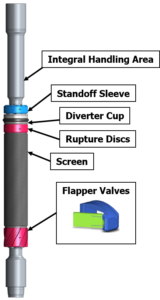
If drilling of cement or accessories is planned, a Junk Basket with integrated screen/catcher tool should be positioned at least 30 feet above the bit/mill and should not be run through any drilled out landing or float collar. The bit or mill should have an OD at least as large as the Stand-Off Sleeve on the Well Patroller and should be designed to drill the cement/accessories into small pieces.
A Junk Basket with integrated screen/catcher tool is normally recommended in addition to a Casing Scraper and Casing Brush to clean and prepare the ID of the casing/liner where the deviation is in excess of 30 degrees or where a production or test packer is to be set.
A Junk Basket with integrated screen/catcher tool is recommended for all casing and liner strings in an injector well.
If running a Junk Basket with integrated screen/catcher tool into a liner where drilling of cement or accessories is planned, a Heavy Duty Casing Scraper should be run ahead of this tool. This will ensure that the tool does not encounter a potentially damaging sheath of cement.
A Junk Basket with integrated screen/catcher tool should not be run through perforations.
Ensure that this tool is not run above any ball operated tools which require a ball equal to or larger than the size to which it has been drifted.
This tool is also can be used for dedicated BOP/Wellhead clean-up with configuration is above TIW valve or Bullnose, below BOP Jetting Sub and below Wear Bushing Retrieval Tool.
Where there is a tapered production casing string, this tool (dedicated BOP/Wellhead clean-up type) would normally be placed in the topmost string of casing. In some case where the upper string is very short or it is not possible to run that size through a wellhead restriction or it is preferred to re-run the same size tool as during the main clean-up, this tool can be run into the lower casing string.
Ferrous Debris Catcher (Magnet Tool)
Various type of ferrous debris catcher tool in market. This tool should be recommended during any milling operation, and carried out as part of the clean-up sequence.
The position of this tool is above or below the Junk Basket with integrated screen/catcher tool and above casing scraper and casing brush tools.
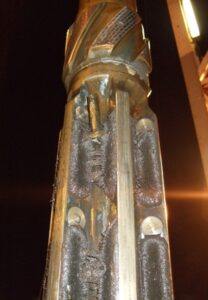
Ensure that this tool is not run above any ball operated tools which require a ball equal to or larger than the size to which it has been drifted.
Riser Brush Tool
A riser brush tool should not be run into Riser Flex Joint. Always ensure that this tool is not run above any ball operated tools which require a ball equal to or larger than the size to which it has been drifted.
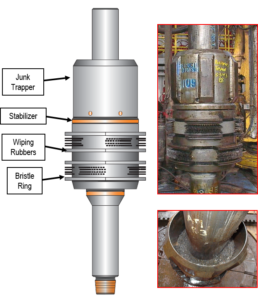
The position of this tool is above the BOP Jetting Sub or any other available jetting tool. Above the Junk Basket tool and above TIW valve or Bull Nose.
Read also :
Wellbore Cleanout and De-burring Operations – A Proposal Program
Well Displacement – Oil Well Pre-Completion
Wellbore Cleaning Services – a Proposal for South Tongkol 1X well
Wellbore Clean Out Services Program for Tangguh Integrated Drilling Program – a Proposal


You actually make it seem really easy with your presentation however I in finding this matter to be really something which I think I might never understand. It kind of feels too complicated and very vast for me. I’m having a look forward to your subsequent post, I will attempt to get the dangle of it!
Good shout.